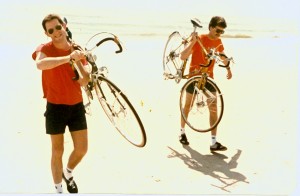My friend Bruce unearthed this old photo of us walking across the sand at Virginia Beach after dipping our rear tires in the Atlantic Ocean to start our cross-country bicycle tour in 1984.
After our ceremony, we climbed in a car with our girlfriends and drove to Yorktown, Va., where we actually started our 11-week tour.
It seems odd to start a bicycle tour with a ceremonial tire-dipping, then jump in a car and drive to a location to start, but that’s what we did.
No cellphones
As I think back to that TransAmerica bicycle tour that started 30 years ago today, I’m reminded of other stuff that seems odd, when compared to bicycle touring today.
— We carried no cellphones; hadn’t been invented yet. Ditto with laptop and notebook computers. The only way to stay in touch was with a small bag of quarters and a vigilant look out for pay phones at gas stations and roadside cafes. We also sent postcards, via snail mail.
— Think of that. A week or two would go by and no one would know where we were. Seems sketchy now, but then it was normal.
— Our bikes weren’t equipped with bike computers. Although digital devices might have been available then, the only device I was aware of at the time was a counter that attached to the front hub. Obviously there was no GPS. This all made way-finding a little difficult, even with a set of Bikecentennial maps.
— The closest thing we had for energy bars were Fig Newtons. Also ate lots of Mother’s brand cookies. PowerBar had just been developed in 1983. Energy gels were a good decade down the road. Gatorade — lemon-lime flavored — was widely available, but I don’t remember drinking it. We partook mainly of water and orange juice, with the occasional Pepsi or coffee for a pick-me-up and beer in the evening where it was available.
No lycra
— Didn’t have an ounce of lycra. We did have bicycle shorts with chamois, but they didn’t stretch and they had pockets. Same with our tops — T-shirts and sweatshirts only. I know I used some man-made fabrics, as I remember a pair of socks melting in a dryer.
— No carbon fiber. My bike was a steel Fuji (I still ride steel); Bruce’s was a new fangled aluminum bicycle made by Cannondale.
— No Kevlar tires. We probably spent the equivalent of one or two days fixing flats.
— Although we thought we had trained for our bike tour, the day we left was the first time we’d headed down the road with all our gear. We covered 274 miles in our first 7 days, and 453 miles in our last 7 days. Our first week included a rest day in Charlottesville where we went to the post office and sent a bunch of stuff home.
— We carried small point-and-click cameras; digital cameras weren’t available. We shot Kodachrome and Ektachrome slides. We didn’t see the results until we returned home and had the film processed. As you can see from the image above, the colors already are washing out.
— The estimated US population in 1984 was 235.8 million. Today it’s 313.9 million. That’s a 25% increase.
— Motor vehicle highway mileage has risen about 40% in about the same period (2012 and 1984).
Journaling
We carried spiral notebooks on our travels and wrote down a lot of what we observed and experienced. I turned that into a TransAmerica Journal, which after a hiatus of a couple of years, I’m reprinting here again.
That’s terribly redundant to those of you who have read it before, but there always seems to be new readers who enjoy the stories. Also, I enjoy reliving them as well. At risk of boring everyone to death, I’ll begin posting them today.
It starts with May 13, 1984: “Dude — Where’s my campground?”


4 comments
Skip to comment form
What a ride! Happy 30th anniversary of your trip.
Still studs…both of you!!
What makes so challenging that you guys did it from east to west,
Your journal will help my 3rd leg cross country journey, will be reading all your posts.
Thanks
Author
Good luck on your travels, Sam.
As I recall, the prevailing winds didn’t cause us much of a problem. When we crossed Kansas, the winds were trending from the south. That made east to west riding a little dicey in traffic, but we flew on those sections heading north.
I think the biggest difficulty about the east-west route was crossing the Appalachians before we were in good shape. Of course, the Ozarks were difficult, and we should have been in “peak” form by then.